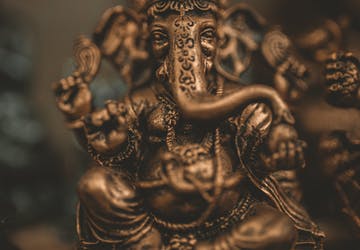Mantra: A method of pratyahara or withdrawal of the senses
In the 90’s while driving my kids to school in a carpool we often played Om Namaha Shivaya, a recording made by Robert Gass. Robert Gass later described asking his yoga practicing grandmother the secret to her vigor. She told him she had read in a yoga book to choose an Indian word as a man-tra (pronounced with a short a) and repeat it over and over. She chose the word Cheyenne. Neither Robbie Gass’ grandmother nor I had been formally schooled in mantra, yet we both were en”chant”ed by sacred sound.
A yoga class usually begins with the chanting of mantras. Mantra is a method of pratyahara, or withdrawal of the senses, and one of the eight limbs of yoga. Mantra gives sanctity and concentration to our practice. In Light On Pranayama, B.K.S. Iyengar wrote “In meditation chanting of mantras is sometimes given to the beginner to steady his wandering mind and to keep him away from worldly desires.”
A yoga class usually begins with the chanting of mantras. Mantra is a method of pratyahara, or withdrawal of the senses, and one of the eight limbs of yoga. Mantra gives sanctity and concentration to our practice. In Light On Pranayama, B.K.S. Iyengar wrote “In meditation chanting of mantras is sometimes given to the beginner to steady his wandering mind and to keep him away from worldly desires.”
Mantra: Tradition of sacred sound
antra is part of the universal tradition of sacred sound. It has the power to move us deeply, bringing us into harmony with the spirit. Mantra comes from the Sanskrit word ‘tra’, which means tool, and ‘manas’, which means mind. It is an organized and codified spiritual science. The Rig Veda, the oldest yogic text, consists of sacred chants. The great Upanishads contain sections on mantra and primal sound.
Reality consists of vibration, which in essence is sound. Hearing is the least gross of the five senses and is paired with speech and the voice. Mantra connects us to the vibratory pattern behind the universe itself. Each of us has a unique sound pattern that sustains everything we do: we move and grow or stagnate and decline. Words carry energy and mantra can attune our body and mind to the proper resonance.
Reality consists of vibration, which in essence is sound. Hearing is the least gross of the five senses and is paired with speech and the voice. Mantra connects us to the vibratory pattern behind the universe itself. Each of us has a unique sound pattern that sustains everything we do: we move and grow or stagnate and decline. Words carry energy and mantra can attune our body and mind to the proper resonance.
Sanskrit: Beyond the overt meaning of words
Each of the words in Sanskrit has a vibratory meaning in addition to its overt meaning. One could say that Sanskrit is a product of phonetic engineering. The letters of the Sanskrit alphabet allow the human mind to interface with the universal. For example, A, I and U are the three primal vowels which are the basis for all other sounds and all of creation. The A sound relates to the sense of self, life, being and deeper awareness.
The U sound allows energy to manifest in the outer world. The mantra Om, said to be the first sound at the creation of the universe, is pronounced A-U-M. When we use the Vedic mantras along with the breath and meditate on their profound meanings, we become connected to yogic philosophies and the flow of energy and grace.
The U sound allows energy to manifest in the outer world. The mantra Om, said to be the first sound at the creation of the universe, is pronounced A-U-M. When we use the Vedic mantras along with the breath and meditate on their profound meanings, we become connected to yogic philosophies and the flow of energy and grace.
"Mantra is probably our best tool available for psychological well-being....
It is a way to turn our minds, which are often our worst enemy, into a friend of our higher Self"
It is a way to turn our minds, which are often our worst enemy, into a friend of our higher Self"
Dr. David Frawley
Kinds of Mantras
There are many different kinds of mantras. There are the simple one syllable, primal sound, or bija, mantras like OM; there are mantras to deities like Saraswati, Ganesha and Lakshmi. The “Ga” sound in Sanskrit indicates movement, expression, accomplishment, structure and order, It indicates to go, to get, to achieve, to express, to count and control. It increases our level of skill, functionality, dexterity and expertise. The Ganesha mantra will help remove obstacles in every part of the body and mind and are often chanted by students as an aid to learning. Mantras are used in Ayurveda in healing, Mantras to Lord Dhanvantri are usually chanted before classes in Ayurveda. Many scholars think Lord Dhanvantri and Patanjali were the same person. A mantra to Patanjali is typically chanted before a yoga class.
| | | |
Questions? Contact me at [email protected]
www.pranarasa.com
Copyright © 2020 Prana Rasa, All rights reserved.
Our mailing address is:
Prana Rasa
931 Briarcliff Rd
Tallahassee, FL 32308
Add us to your address book
www.pranarasa.com
Copyright © 2020 Prana Rasa, All rights reserved.
Our mailing address is:
Prana Rasa
931 Briarcliff Rd
Tallahassee, FL 32308
Add us to your address book



